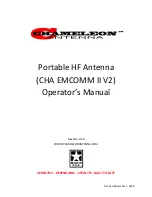
CHA EMCOMM II V2
Page 7
Antenna Configurations
Using the supplied components, the CHA EMCOMM II V2 can be deployed into a number of useful
configurations. Three configurations, see table (2), are described in this manual, each with unique
performance characteristics. The table can assist the operator to quickly select the most appropriate
antenna configuration to meet their operational requirements.
Configuration
Ground Short Medium Long Directionality
Horizontal NVIS
↓
↑
Omnidirectional
Sloping Wire
↓
↕
Omnidirectional
Inverted “L”
↓
↕
Unidirectional
Table 2. Antenna Configuration Selection.
To use the table, decide which distance column (Ground = 0 to 90 miles, Short = 0 - 300 miles, Medium =
300
–
1500 miles, Long > 1500 miles) best matches the distance to the station with whom you need to
communicate. Then, determine if the OWF is in the l
ower (↓ = 1.8 –
10 MHz) or upper (↑ = 10 –
30
MHz) frequency range. Finally, select the CHA EMCOMM II V2 configuration with the corresponding
symbol in the appropriate distance column. All CHA EMCOMM II V2 configurations provide some
capability in each distance category, so depending upon the complexity of your communications
network, you may need to select the best overall configuration. The directionality column indicates the
directionality characteristic of the antenna configuration. When using NVIS, all the configurations are
omnidirectional. Most configuration and frequency combinations will require a wide range antenna
tuner or coupler.
Horizontal NVIS
The CHA EMCOMM II V2 Horizontal NVIS configuration, see figure (1), is a special configuration designed
to provide good NVIS propagation on lower frequencies. It is predominately omnidirectional and
provides medium range sky wave propagation on frequencies above 10 MHz. It requires two supports
that will enable the antenna to be raised to a height of 10
–
12 feet. A counterpoise wire with a length
of 50 to 55 feet is recommended. If a counterpoise wire is not used, the coaxial cable must be 25 to 100
feet in length, as the shield of the coaxial cable provides the counterpoise. Use the following procedure
to install the Horizontal NVIS configuration.
Figure 1. Horizontal NVIS Configuration.

































